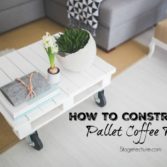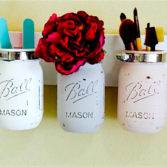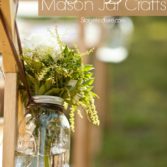Entry #286, September 25, 2010
Your kitchen is the most expensive and sought after room in your home when it comes to home buying/renovation. Kitchen cabinets and appliances rank at the top of the expense list. If you are in the process of renovating your kitchen cabinets, have you thought about painting instead of replacing? Today on DIY Saturday, here are tips for painting your kitchen cabinets and making them look brand new, for the fraction of replacing them.

Painting kitchen cabinets can save you money!
Here are the following steps for painting kitchen cabinets from Do it Yourself.com
1. Clean the cabinets.
Preparation is the most important step in the process of painting your cabinets, and it is very important to make sure that all of the surfaces you are going to paint are completely free of all grease, grime, food residue and whatever else may be stuck to them. You will find the entire process is much easier if you remove all the cabinet doors. Once you have taken them all down, find a place where you can lay them out flat. Use an all purpose cleaner and a rag and then allow them to dry thoroughly.
2. Sand the cabinets.
Once they are dry, use a piece of fine grit sandpaper – 150 or finer – and make a few passes over all the flat surfaces of the doors. Don’t forget to do the thin facing pieces on the cabinet boxes themselves. The slightly sanded surface will allow the primer to bite and hold onto the cabinet surface. It can be a tedious process, but taking the time to lightly sand your cabinets before you prime and paint them will greatly increase longevity of the paint job. Don’t underestimate the importance of this step!

3. Apply primer.
After sanding, it’s time to prime the cabinets. Primer forms a better bond with the surface than paint alone would. This means that the paint is less likely to chip and peel if it gets bumped with dishes or pots and pans. If your cabinets are already painted and you are re-painting them the same color, it is OK to skip this step and go ahead and apply the paint. If, however, your cabinets are stained and you are trying to cover up the natural wood grain with paint, you must prime them first. The paint will not stick to the varnished surface and the color of the stain will most likely bleed right through your paint.
There are several types of primer that you can use, and which one you choose is largely based on what kind of paint you want to use over the top. If you are using an oil-based paint, an interior oil based primer is recommended. These products tend to have a very strong odor and they are best used when you can properly ventilate the room. The best option would be to take all the doors that you removed out to the garage and paint them there with the overhead door open.
If you are planning to use a latex paint for your top coat, then a shellac based primer is recommended. This product tends to dry fairly quickly, so make sure that you are ready to go before you begin applying it. The shellac based primers, just like the oil based, carry a very strong odor and caution should be used.
4. Paint the cabinets.
At this point, after sanding and priming, your cabinet doors probably look awful! Don’t worry, you’ve built a great foundation for the top coats of paint, which will bring your kitchen bouncing back to life. There are several ways to apply the paint. A pneumatic sprayer is the best way to get a smooth and glossy finish. If you don’t have access to one, however, don’t panic – you can still get a great finish by using a high quality paint brush. 2 1/2″ to 3″ would be ideal.
The key to achieving a professional finish with a brush is to use very thin coats. It may be tempting, after all the work you’ve already to done, to try to coat the paint on as thick as possible just so you can be finished. This is not a good idea. The best and most durable paint jobs are built up by consecutive thin layers of paint, not just one thick one.

Update your kitchen with the simplicity of a paint brush
5. Add additional coats.
Lightly apply your first coat and let it dry completely. If you really want to achieve a professional finish, take some 400 grit sandpaper and very lightly sand the flat surfaces again. You are not trying to remove the paint, but instead are insuring that the next coat has the smoothest possible surface to adhere to. Once that is complete, add your second coat.
In most cases two coats of paint will be sufficient. Occasionally, though, you may find that you get better results from three. This is often true with woods that carry a heavier grain, like oak. Once the doors are painted and fully dry, simply hang them back up, sit back, and enjoy the bright, clean and renewed space that you’ve worked so hard to achieve.
You Tube Video:
How to Paint Kitchen Cabinets
For more kitchen & bath ideas on Stagetecture, click here.
Receive Stagetecture's Daily Lifestyle Ideas
FREE - Daily emails with recipes, home decor, D.I.Y, and lifestyle tips! : ) Who doesn't need help?






I am really interested in painting my kitchen cabinets and I really like how the kitchen turned out in the last picture above with the dark brown paint. Do you have any more details on the project e.g. paint color used and a before picture?
Sorry Pete, I don’t have that information. I got the image from google. 🙁
We just bought a short-sale house which needs some TLC! We’re planning to paint our builder grade oak cabinets some type of darker color, but we’re having trouble choosing a shade. The kitchen is open to the family room but due to a fairly high brick wall in the back yard, the rooms don’t get a lot of sunlight. We don’t want white cabinets, do you have some suggestion on choosing a chocolate type color that may work in this situation? Oh, the kitchen is huge, but not tiney either. Thanks.
Hi Rhonda, if you’d like to send me some pictures of your space, I may be able to help you better. 🙂 Fill out the contact form and I will email you my email if you’re interested.
I too like the brown painte, so I have printed the picture and will take it to Lowes or Home Depo to see if they can match it up
I just finished painting my cabinets and they are a close match to the shade of the last picture. The color I chose was called Swiss Chocolate from Valspar
Thanks Kyle – sounds like a great DIY project! 🙂 Thanks for you comment!